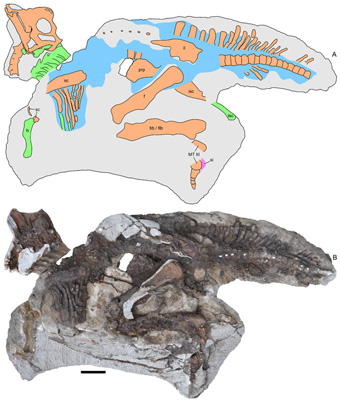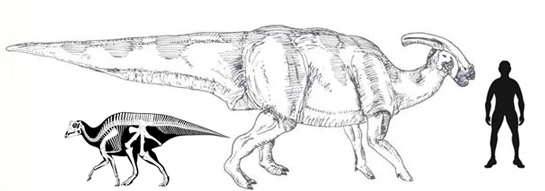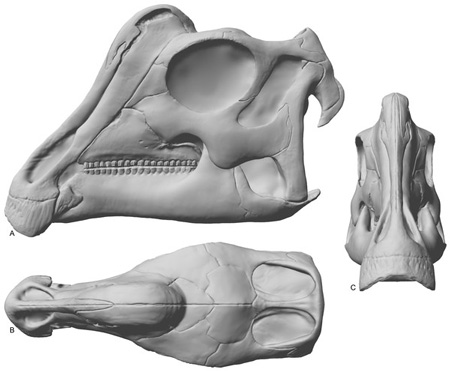Introducing “Joe” – The Baby Parasaurolophus
Fossils of baby dinosaurs are exceptionally rare, however, when found they can provide palaeontologists with a wealth of information. Scientists can gain an understanding of how dinosaurs grew, how their bodies changed as the animal got older and in some cases how quickly dinosaurs matured. The large amount of duck-billed dinosaur fossils found in western North America has enabled researchers to piece together the growth stages of a number of herbivorous dinosaurs and thanks to a sharp-eyed student, scientists at the Raymond M. Alf Museum of Palaeontology in Claremont (California), have a near complete, less than one-year-old baby Parasaurolophus to study.
Baby Parasaurolophus Fossil
High school student Kevin Terris discovered the fossils back in 2009. It was a chance discovery as palaeontologists had been at the same location just a couple of days earlier but they had failed to spot the articulated specimen eroding out of the rock. The baby Parasaurolophus, which has not been assigned to a particular species within the Parasaurolophus genus, represents one of the most complete baby hadrosaurs discovered to date.
The fossils have been dated to around 75.5 million years ago (Campanian faunal stage of the Cretaceous) and come from the highly fossiliferous Kaiparowits Formation in the Grand Staircase-Escalante National Monument in southern Utah.
A View of the Right Lateral Side of the Specimen (A = Line Drawing, B = Actual Fossil Material)
Picture credit: PeerJ Journal
The interpretive line drawing (A) shows bones bounded by solid lines and coloured orange. The blue shaded areas show fragmented and highly weathered bone material, whilst the green areas show places where bone impressions can still be seen. The small, pink area at the bottom of the right hand side of the picture (a foot), indicates the presence of skin impressions.
A Dinosaur Named “Joe”
The baby Parasaurolophus has been named “Joe” in honour of Joe Augustyn, a long-time patron of the museum whose family sponsored the preparation of the fossil material. It measures approximately 2.5 metres in length, less than one quarter the size of an adult Parasaurolophus. It did however, have a low bump on the top of its skull, the first signs of that long, tubular, swept-back crest that helps to distinguish this lambeosaurine dinosaur from other duck-bills.
Andrew Farke, a palaeontologist and the lead scientist on the study project that has taken nearly four years to complete commented:
“Our baby Parasaurolophus is barely 25% the size of an adult, but it had already started growing its crest. This is surprising, because related dinosaurs didn’t sprout their ornamentation until they were at least half-grown. Parasaurolophus had to get an early start in order to form its unique headgear.”
Crest Development in Lambeosaurine Dinosaurs
Studies of a related lambeosaurine dinosaur, Corythosaurus, suggest that Corythosaurus spp. did not begin to develop crests until their skulls were approximately half the size of an adult’s. “Joe” may have needed to start sprouting his crest early as in some species of Parasaurolophus, notably P. walkeri the crest in adult males could reach lengths in excess of two metres.
An Illustration of an Adult Parasaurolophus with “Joe” and a Human Figure for Scale
Picture credit: Raymond M. Alf Museum and Everything Dinosaur
The study of growth in organisms is called ontogeny. The research team analysed cross-sectional areas of the fossilised bones and found that the bone tissue was filled with many large blood vessels, indicative of rapid growth in extant animals. Furthermore, Sarah Werning (Stony Brook University), a co-author of the scientific paper published in the academic journal “PeerJ” could not detect signs of an annual growth ring in the bone samples studied. This suggests that this dinosaur was less than twelve months old when it died, yet it had already grown from the size of a small dog to the size of a Guernsey cow.
Post doctoral research fellow Sarah stated:
“We didn’t see even one ring [growth ring]. This means that it grew to a quarter of its adult size in less than a year.”
Dinosaur Ontogeny
This supports previously published research that was reported upon by Everything Dinosaur team members. The ontogeny of another lambeosaurine dinosaur from North America – Hypacrosaurus had shown that some types of dinosaur must have grown rapidly. The most likely explanation for this is the need to grow up fast to avoid being eaten.
To read more about the Hypacrosaurus study: Hadrosaurs Grew Up Fast To Avoid Being Eaten by Tyrannosaurs.
The completeness of the specimen in conjunction with the fossils being that of a baby Parasaurolophus enabled the research team to examine other aspects of these dinosaur’s anatomy.
For example, striations found in association with the jaws revealed the location of the keratinous beak. CAT scans allowed the scientists to study the nasal passages of this young dinosaur. From this work, the team concluded that baby dinosaurs such as this Parasaurolophus were probably not capable of producing deep, low frequency sounds. Instead, baby dinosaurs such as “Joe” the Parasaurolophus may have vocalised in a very different way to the adults. Perhaps it “chirped” and “tweeted” at a higher pitch than older animals in the herd.
Computerised Tomography Reveals Details of the Baby Dinosaur’s Skull Morphology
Picture credit: Ville Sinkkonen
The picture above shows a computer generated image of the baby dinosaur’s head. A = lateral view (view of the more complete left side of the skull), note the large eye socket (orbit). View B is a dorsal view, viewing the skull from the top down. View C is viewed from the front (rostral). In the rostral view, the beak (rhamphotheca) can be clearly seen. The shape and size of the beak has been inferred based on rock striations found in association with the jawbone that indicate the position of the beak and its relationship to the predentary and the premaxilla.
The fossil material is now on display at the Raymond M. Alf Museum of Palaeontology and we are grateful to the museum for their help in the compilation of this article.
For models and replicas of Parasaurolophus and other Late Cretaceous dinosaurs: Wild Safari Prehistoric World Figures and Replicas.








So cute